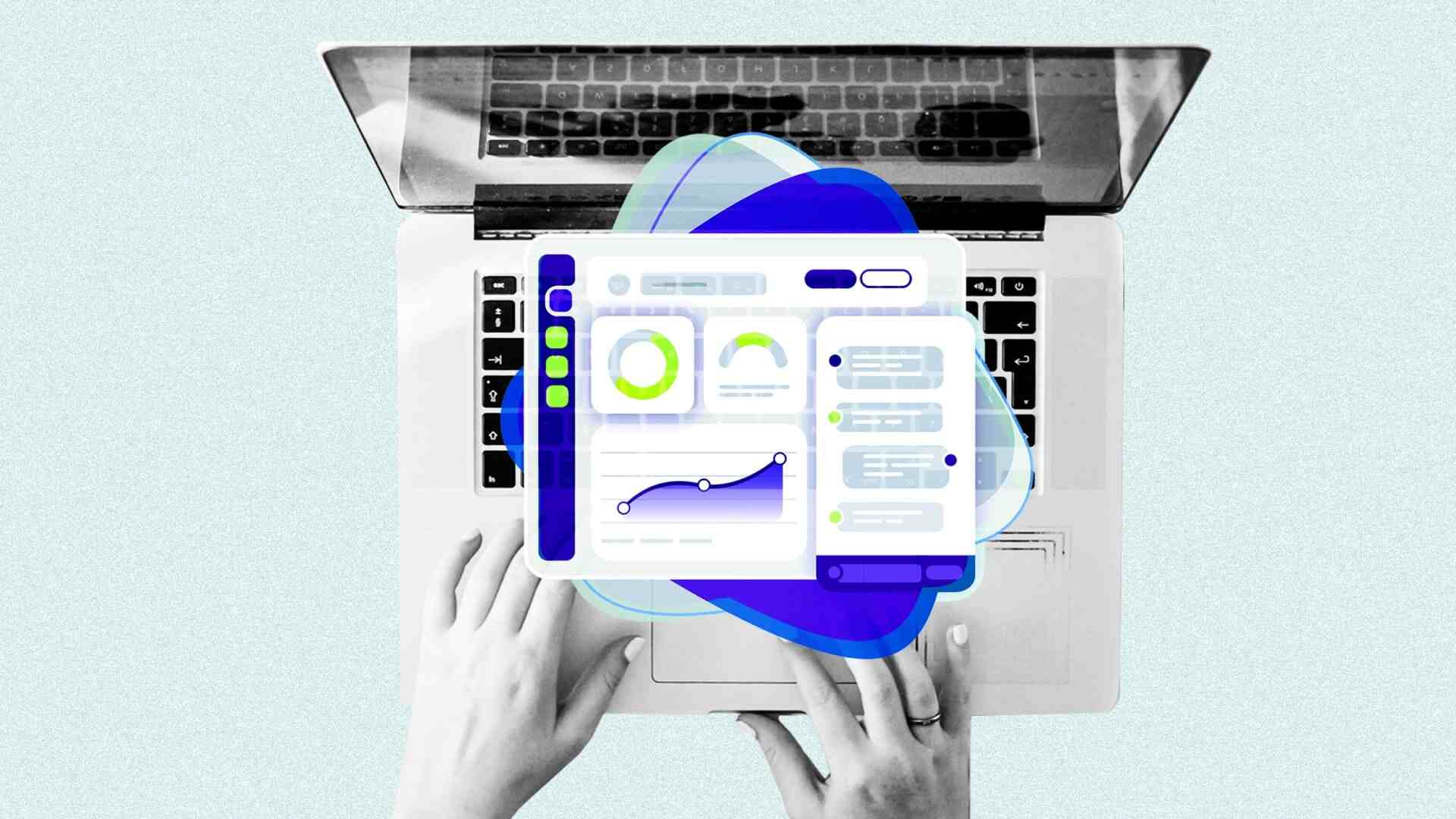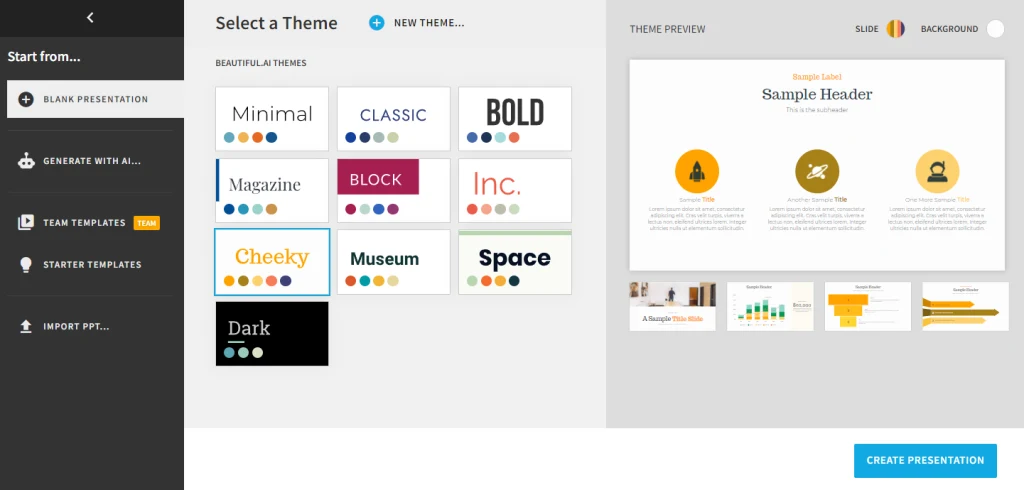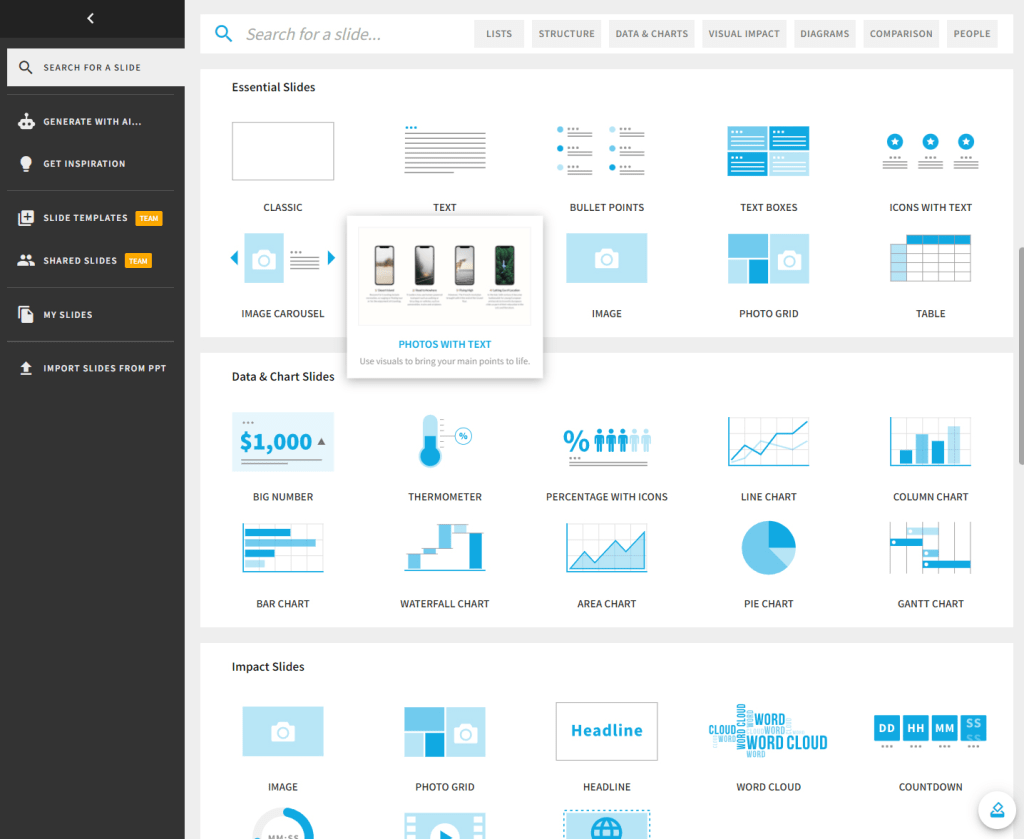- | 8:00 am
Forget PowerPoint: This is the AI presentation app of the future
Seven-year-old Beautiful.ai is showing just how good AI-enhanced slideshows can be—and making traditional tools like PowerPoint and Google Slides seem like clunky old relics.

It’s tough to think of two words that seem more at odds with each other than “beautiful” and “presentation.” I mean, have you seen a PowerPoint slide deck lately?
That disconnect is something Mitch Grasso’s been grappling with for years. In fact, it wouldn’t be a stretch to describe it as motivating his life mission at this point—to achieve the impossible-seeming feat of turning mundane digital presentations into something both beautiful to behold and enjoyable to create.
“‘I love PowerPoint’ is not something you hear a lot of people say,” Grasso deadpans. “People hate PowerPoint, and they’re always frustrated . . . but it’s not really PowerPoint that’s the problem.”
Grasso firmly believes the issue is less the tool itself and more the process it puts you through—something that applies equally, he says, to Google Slides and other PowerPoint alternatives. And that’s why he’s come up with a web-based and native desktop presentation platform called Beautiful.ai, which he describes as the “anti-PowerPoint.”
This is actually Grasso’s second stab at solving the presentation puzzle. In 2007, he founded SlideRocket, a startup he sold to VMware a few years later. But before you jump to conclusions, hang on a sec: While his latest creation does sport two increasingly common letters at the end of its name, Beautiful.ai isn’t yet another rushed-out generative AI also-ran. Beautiful.ai has been around for nearly a decade now. And the seeds of its soul stretch back to Grasso’s earlier creation, when he first started exploring how presentations could be reinvented.
As someone who’s used the service for a while, let me tell you: Even if you’re late to the Beautiful.ai party, you’ll be very glad you got there.
THE BEAUTIFUL.AI PRESENTATION PHILOSOPHY
The first thing you notice when you get into Beautiful.ai is almost shocking: The service is, dare I say it, actually delightful to use. Grasso really did identify an area ripe for reinvention: Beautiful.ai takes all the typical pain points out of presentation creation and turns it into a simple process that’s surprisingly swift and pleasant.
The crux of the whole experience revolves around Beautiful.ai’s intelligent algorithms for helping you find the best way to format and design whatever type of presentation you’re building. If you’re starting from a blank slate, the app gives you a handful of suggested themes to get things going—motifs like “Minimal,” “Classic,” “Bold,” and even “Cheeky.” Or, if you’d rather, you can pick from a library of starter templates for everything from sales pitch presentations to marketing reports and all sorts of other common company needs.

But it’s once you get into the presentation that the magic really becomes apparent.
With each new slide you create, Beautiful.ai encourages you to pick from a sprawling menu of common slide design frameworks, all of which are available as part of the service’s $144-a-year Pro-level subscription (which includes a 14-day free trial). You could use simple text boxes, for instance, or a fancy photo grid. You could build all sorts of data-centric charts and visual info representations. You could create a timeline graphic of a company’s journey, with key moments highlighted along the way. Or you could give yourself blueprints for org charts, quote showcases, team member introductions, and even slick-looking product screenshots—all with a single click.

And then, as you’re working on slides, Beautiful.ai intelligently adapts the design at every step along the way—putting formatting on “autopilot,” as Grasso describes it. As you add additional elements, the software instantly shifts other elements around and makes everything look good—with virtually no time or effort required. You absolutely can take control and customize things as you see fit, if the urge strikes, but in my experience, very little adjustment needs to be done.
This automation is where the AI in Beautiful.ai’s name comes into play. While AI has now colloquially come to be understood as involving generative chatbot-like technology—à la ChatGPT or Google Gemini—Grasso latched onto the term in the pre-GPT days, when it referenced all manners of algorithm-driven adaptation.
“I was less concerned with the set of technologies that were behind us and more about the experience of automating and influencing the way your presentations are created,” he says.
It’s something the Beautiful.ai team has come to refer to as “design AI,” a fancy way of referencing the logic surrounding how elements on the screen are automatically laid out and optimized for you as you work. And that’s the most important value Beautiful.ai provides. It’s what drew me to the service a few years ago and has kept me coming back to it ever since.
REIMAGINING THE ‘AI’ ELEMENT
As simple as it already was to start a new Beautiful.ai presentation, the relatively recent addition of generative AI into the service adds even more convenience into the equation, for anyone wanting to go down that path.
When creating a new Beautiful.ai presentation, for instance, you can now opt to start by providing a plain-text description of what you need—”a presentation on the workplace transformation and the future of work,” “an investor pitch deck for a Series A SaaS company in the B2C FinTech space,” or “a board deck for Q1 revenue, growth, and new customers,” to use a few of the service’s sample prompts. Beautiful.ai will then pull in publicly available data and build a complete presentation for you. You’ll almost certainly need to edit and refine it, but you’ll start with something, at least—and you might just find a fair amount of your legwork finished before you even begin.
You can also provide extra context for training the AI around your specific info and data—by uploading a file, referencing a web link, or pasting in text—and once you’re in the midst of editing a presentation, you can click a special AI button to summon tools for generating text, shortening or lengthening text, and rewriting text to all sorts of other specifications.

The beauty, though—as it were—is how this is just a first step with Beautiful.ai. It’s what happens next, with the software’s design smarts, that makes it all matter.
“Generative AI is great for getting you started,” Grasso explains. “But the continued editing and the continued manipulation of the content that it’s created is the important part and why we’ve continued to be successful.”
Grasso says only about 20% of the service’s one-million-plus users are regularly accessing the generative AI features, but their presence alongside the public fascination with AI at the moment has absolutely led lots of new people to find Beautiful.ai lately. The service’s active user base increased three times over in 2023, in what Grasso describes as an “unprecedented” level of growth. And many of those explorers have ended up sticking around for the long haul—not because of the generative AI elements, Grasso believes, but because of Beautiful’s longer-standing central advantages.
“It made us more powerful kind of overnight and added this great functionality, but it doesn’t really change the core reason for why Beautiful exists,” Grasso says. “You can’t just wrap ChatGPT in an interface and call it a day.”
That realization makes Grasso especially optimistic about Beautiful.ai’s future, even at a time when the term “AI” is getting tossed around endlessly and everyone from Microsoft and Google to smaller startups are experimenting with inserting extra smarts into presentation software.
“What it really comes down to: Is it something that you’re going to use again and again and [that] really provides value?” Grasso asks. “And at least so far . . . I haven’t really seen that so much from the competitors yet.”
Grasso is focused next on both expanding Beautiful.ai’s generative AI capabilities even further and finding other places where the service’s approach could be beneficial—whether that’s within documents or other visual creations where design and knowledge work intersect.
“Productivity is about making people more productive [and] making their work beautiful, whether that means how they work or the output of their work,” he says. “And there are a lot of opportunities to take this technology that we’ve been perfecting over the last half dozen or so years and apply it to these other mediums.”
For now, Grasso is content with the knowledge that he’s building on the dream he’s been chasing since 2007 and—for the moment, at least—leaving tech’s traditional presentation titans in the dust behind him.
Discover all sorts of exceptional tech tools with my free Cool Tools newsletter at The Intelligence. You’ll get a new off-the-beaten-path treasure in your inbox every Wednesday!






































